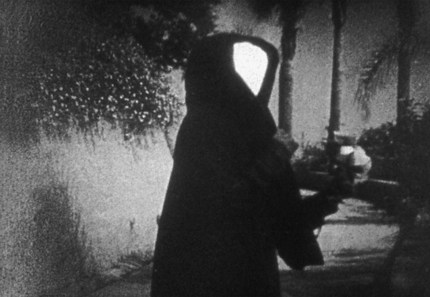A Quick Look at Maya Deren's Meshes of the Afternoon

Meshes of the Afternoon (1943) beings with an arm dropping a single flower on the ground. A woman follows a hooded figure with a mirror face. She drops a key, which later turns into a knife. She goes to her bedroom and watches herself follow the figure and enter the house. She interacts with several other versions of herself; she even tries to kill one. Reflections. Mirrors shatter. The ocean.
That’s Meshes in a nutshell. Of course, the nutshell synopsis doesn’t quite do it justice. Maya Deren and Alexander Hammid were working in the genre of psychodrama. A psychodramatic film is a film in which a person’s conscious or subconscious is recreated on film. Deren was attempting to show the audience what was going on inside her mind.
I love everything about this film. The most iconic and interesting image from the film is probably the hooded figure with a mirror for a face. A close second would be Maya in the bug-glasses, knife in hand, walking through different terrains, on the way to kill one of her alternate selves. Simple, everyday objects (a key, a bread knife) stand out almost as much as the more constructed ones. Many objects disappear or transform in the film through the use of jump-cuts. It’s a simple, but very effective technique. While film is largely a visual medium, it’s important to not only to look at the content but also the discourse.
The film makes use of a spiraling narrative. The same events keep repeating, but they build off of each other and are a little different each time. The repetition here didn’t bore me but drew me deeper inside of the film. I think I was just as bewildered as Maya was watching herself watch herself. The film’s narration is mainly told through an implied narrator (camera lens), but there are other parts that are shown through the Maya and Alexander characters’ point of view.
After doing much reading on Meshes of the Afternoon, it’s clear that everything about it is supposed to have a specific meaning. This was a new concept for me as I saw the film as a surrealist work with many interpretations. According to Sitney, Maya actually hated surrealism and had written pages on the specific meanings of all the different elements in her films.
Some of the images or themes of the film seem to be obvious. Between the mirror figure and the several versions of Maya, I think that the film is mainly concerned with self-identity and reflection. The mirror figure with the flower combined with the key turning into a knife also offers connotations of death or suicide. If the film does have a very specific meaning, could I be wrong in my reading?
Maya says of the scene where she walks across different terrains, walking to stab herself, she was trying to say, “…you have come a long way—from the beginning of time—to kill yourself.” She also mentions that she worried it didn’t come out as clear as she would have liked. I didn’t gather that from my first viewing of the film, but it didn’t make it any less enjoyable.
While everything might have a specific meaning, I think there is enough that can be generally understood to take in and dissect. No one besides Deren and Hammid might ever fully understand every little thing that the film was trying to convey, but if we take the word psychodrama literally, that would be the case if you were able to enter someone else’s mind. You might not understand everything, but there’s more than enough there to keep the viewer interested. Not to mention the meanings they created but were unaware of themselves.
You can watch the entire short film on YouTube here.

Do you feel this content is inappropriate or infringes upon your rights? Click here to report it, or see our DMCA policy.





